Online feedback survey analysis
Introduction To Analysis
This section outlines the responses received from the online feedback survey which ran from Thursday 28 November 2024 until Friday 21 February 2025. The survey questions covered various topics, including ranking satisfaction with the draft outcomes of the Review and the Refined Package, and the opportunity to provide comments on the draft Strategic Environmental Assessment (SEA), Statutory Impact Assessments (SIAs) and draft outcomes of the Review as a whole.
The survey contained 19 questions, with both fixed multiple choice options and questions where comments could be typed in manually. A copy of the online feedback survey is in Appendix G.
A total of 1,409 responses were received via the online feedback survey, including five from stakeholder organisations.
Analysis Methodology Overview
Methodology of closed question analysis
Closed questions in the online feedback survey (Questions 1-5, and Questions 10-19) are those that contained fixed multiple choice options. For certain questions, respondents were able to select more than one answer, meaning that percentages quoted do not always add up 100%. Please refer to Sections 4.3 and 4.4 for a summary of all closed question responses received.
Methodology of open question analysis
Open questions refer to those which provided free text boxes and did not require fixed answers from respondents (Questions 6 to 9). Feedback received in the open questions from five stakeholder groups who attended separate stakeholder briefings sessions (see Stakeholder Engagement Section 3.2 for details of the feedback received from these five stakeholder groups) has been excluded from this section and is therefore not included in the following open question response analysis totals or percentages. The remaining open question feedback responses have been analysed and summarised in Section 4.5 .
Open question responses from the online feedback survey were logged in a consultation database and each respondent given a unique ID. Once uploaded each response was analysed and split into topics, which were grouped under broad headings, referred to throughout the remainder of this report as ‘themes’. If the response mentioned a specific location or place, this was noted along with any other contextual information.
The list of themes identified in the open questions, including a brief overview of some of the topics included within each theme, are as follows:
Active Travel – including references to the Active Communities intervention within the Refined Package and any other active travel suggestions or references.
Bypasses – including support or opposition to named bypasses and requests for other towns to be bypassed.
Climate change/Climate Compatibility Assessment (CCA) – including references to climate change policy, interventions within the Refined Package which seek to address climate change challenges, and references to the CCA.
Consultation – including references to the promotion methodology and adequacy of the consultation undertaken as part of the Review.
Environment/draft Strategic Environmental Assessment (SEA) – including references to environmental impacts and mitigation, and references to the draft SEA.
General comments on the draft Review outcomes – including support for or opposition to the draft outcomes of the Review, where no reference was made to any specific criteria of the Review, such as safety, environment, climate change and so on.
Inclusive and accessible travel along the A96 corridor – including references to current accessibility barriers to travel along the corridor, along with any support or suggestions for creating more inclusive and accessible travel.
Journey times/congestion along the A96 corridor – including references to the causes and potential solutions to congestion along the corridor.
Quality of public transport services – including support or opposition to interventions which seek to improve the quality of public transport along the corridor.
Safety along the A96 corridor – including references to perceived safety concerns along the current A96, along with support for or opposition to the draft outcomes of the Review that relate to safety.
Social and economic impacts – including references to the social and economic impacts of the Review for businesses, growth and the communities along the corridor.
Transport connectivity along the A96 corridor – including references to the connectivity between towns and settlements along the A96.
Some topics raised were considered to be outside the scope of the A96 Corridor Review and have been marked as ‘not relevant’. If a respondent submitted a response but chose not to answer a specific question, this was recorded as ‘no comment’. These responses were logged but are not included in the analysis presented in this report.
Topics classified as ‘not relevant to the A96 Corridor Review’ included, but are not limited to:
References to completed transport schemes in other areas of Scotland.
Support for the A96 Inverness to Nairn (including Nairn Bypass) scheme which was excluded from the scope of the Review as it already has ministerial consent.
References made to temporary diversions or works taking place along the corridor.
The following sections detail the feedback received via the online feedback survey. The order in which the questions are reported begins with the demographic questions, before detailing the responses for Questions 1-9 in numerical order.
Closed Question Analysis: About You
These questions captured anonymous demographic details from the respondents. The data may be used by Transport Scotland and its consultants in other reports connected to the Review.
Please note that the total number of online feedback responses (1,409) has been used for general reporting on aspects such as location, age and so on. As it was not compulsory to answer every question, the number of responses may vary and will not necessarily total 1,409 for each question.
The following sections detail the feedback received via the online feedback survey. The order in which the questions are reported begins with the demographic questions, before detailing the responses for Questions 1-9 in numerical order.
Question 10: Please provide the first part (3 or 4 characters) of your home or business postcode. This will help us understand your comments in relation to the Review.
Respondents were asked to provide the first part of their home postcode. A heatmap showing the location of respondents in the north-east can be found in Figure 4.1. All postcodes provided were in Scotland, with the majority in the north-east, and within the defined A96 study area.
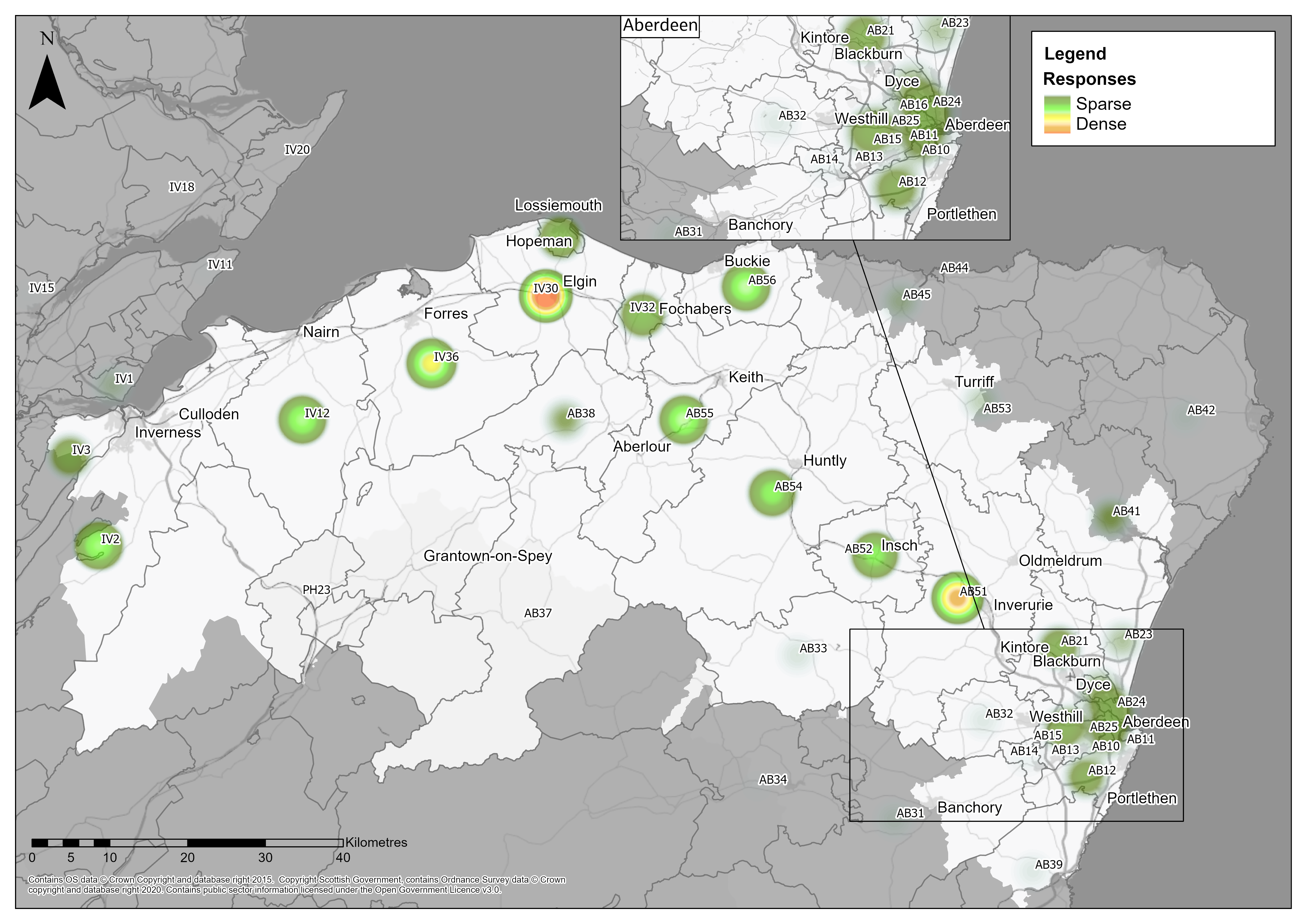
Questions 11 to 14: Please indicate if you are responding as an individual or organisation
Questions 11 to 14 were optional and asked respondents if they were responding as an individual or on behalf of an organisation. Those responding on behalf of an organisation were subsequently given the option to provide the organisation’s details, their role in the organisation, and how the views of the organisation were collated (Questions 12 to 14).
Of the 1,389 respondents who opted to provide a response to Question 11, 97% stated that they were responding as individuals, with 3% responding on behalf of an organisation, as shown in Figure 4.2 .
|
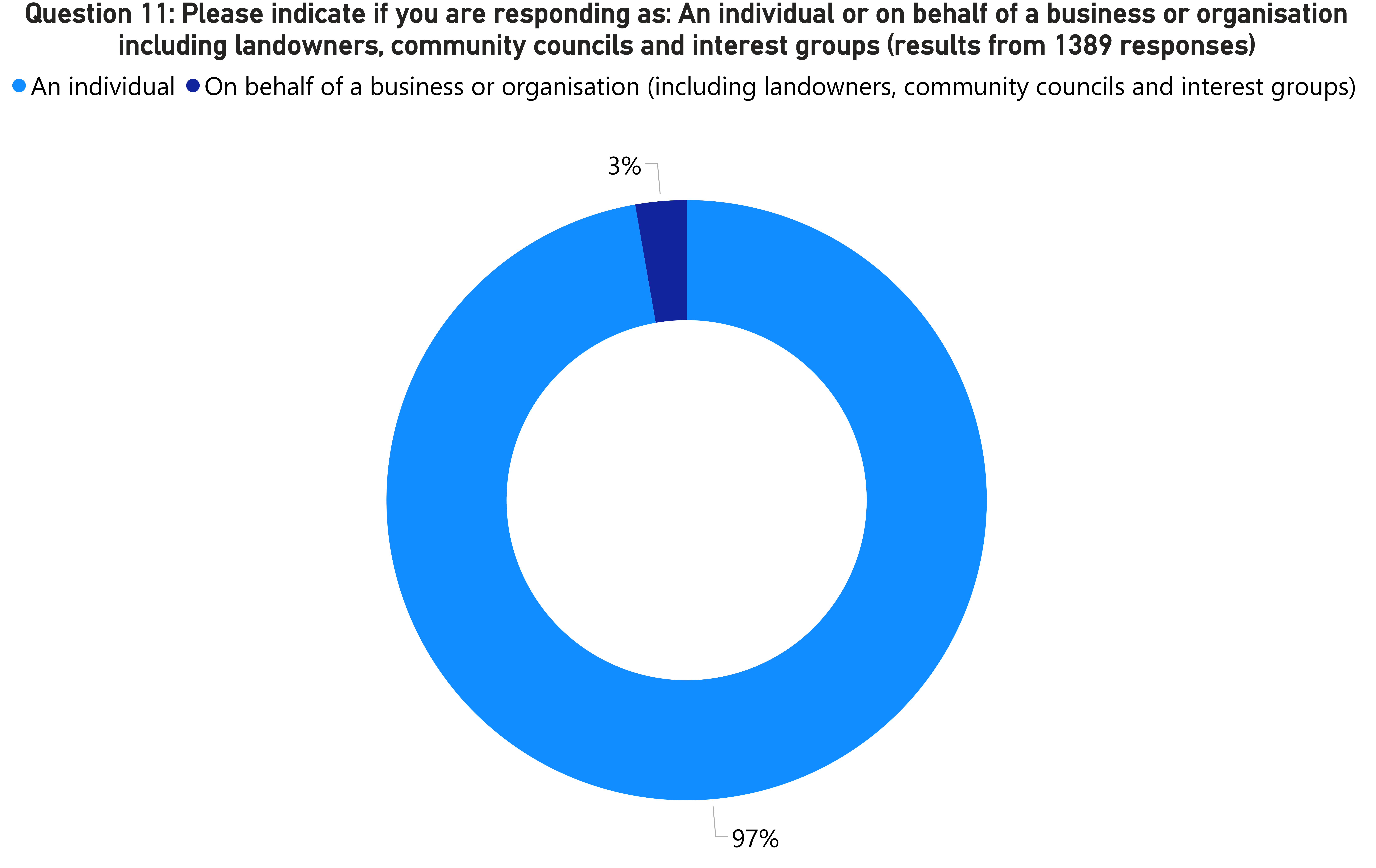
|
Question 15: Were you aware of the A96 Corridor Review prior to this consultation?
Of the 1,262 respondents who opted to provide a response to this question, 60% stated that they were aware of the Review prior to the consultation, 37% stated that they were not aware of the Review prior to the consultation and 3% responded ‘don’t know’. A full breakdown of these responses is shown in Figure 4.3 .
|

|
Question 16: Please tell us your age
Of the 1,377 respondents who opted to provide a response to this question, 44% of respondents were between the ages of 45 and 64, with 17% of respondents being between the ages of 65 and 74 and 16% of respondents between the ages of 35-44. Figure 4.4 provides a full breakdown.
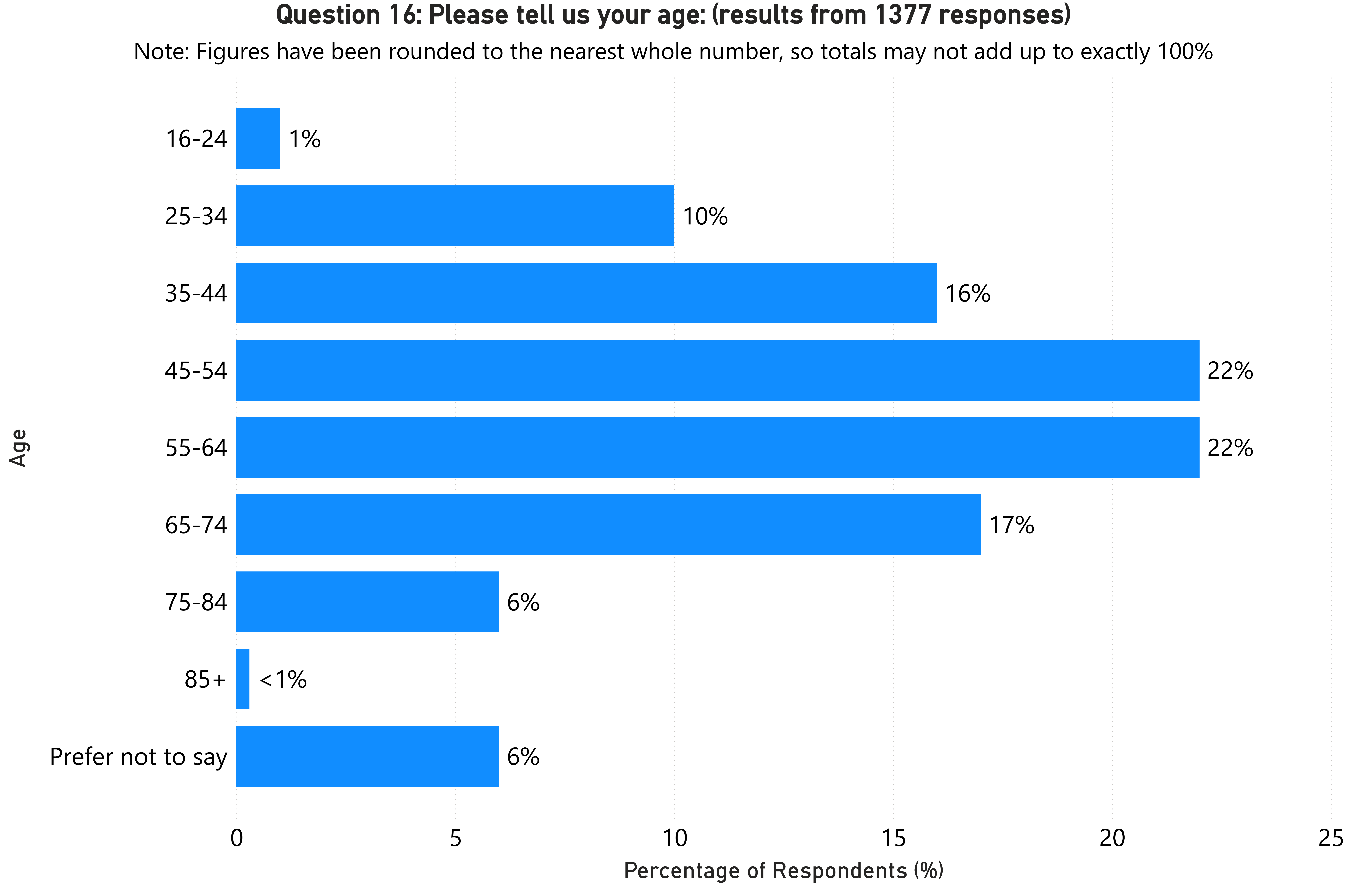
Question 17: Do you consider yourself (gender demographic information)
Of the 1,375 respondents who opted to provide a response to Question 17, which asked respondents about their gender identity, the majority were male, at 61%, with 32% were female and 7% of respondents selecting ‘other’ or ‘prefer not to say’. Figure 4.5 below provides a breakdown of the responses gathered for this question.

Figure 4.5: Donut chart showing the gender demographic information of respondents
Question 18: Do you consider yourself to have a disability such as a physical or mental impairment which has a substantial long term adverse effect on your ability to carry out day-to-day activities?
Of the 1,376 respondents who opted to answer Question 18, 84% stated they did not consider themselves to have a mental or physical disability, 8% stated that they did consider themselves to have a physical or mental disability, and 8% selected ‘prefer not to say’. A full breakdown of these responses is shown in Figure 4.6 .
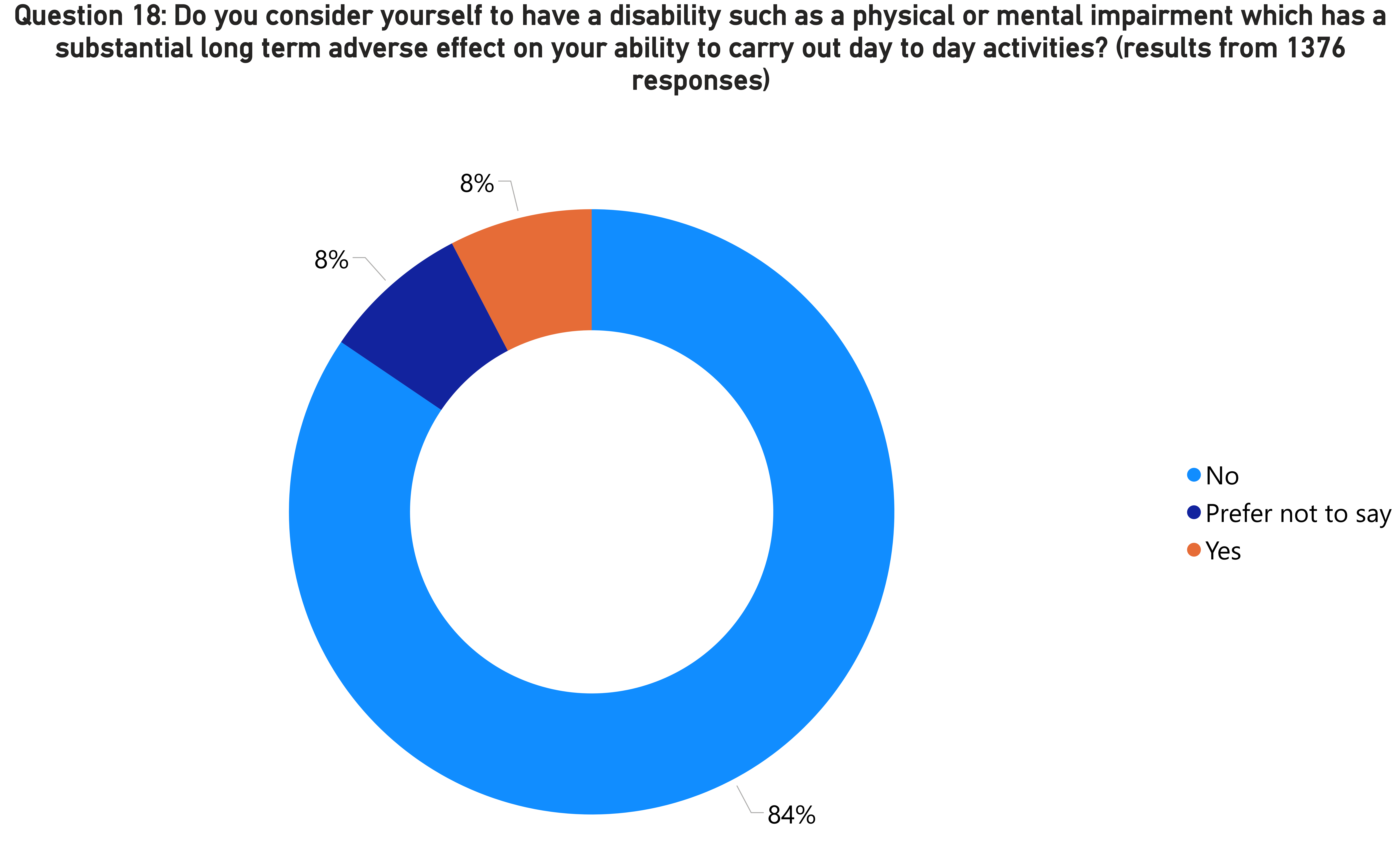
Question 19: Do you use British Sign Language (BSL)?
Of the 1,364 respondents who answered Question 19, 98% stated that they do not use BSL, 1% stated that they do, but not as a first language, and 1% stated they use BSL as a first language. A full breakdown of these responses is shown in Figure 4.7.
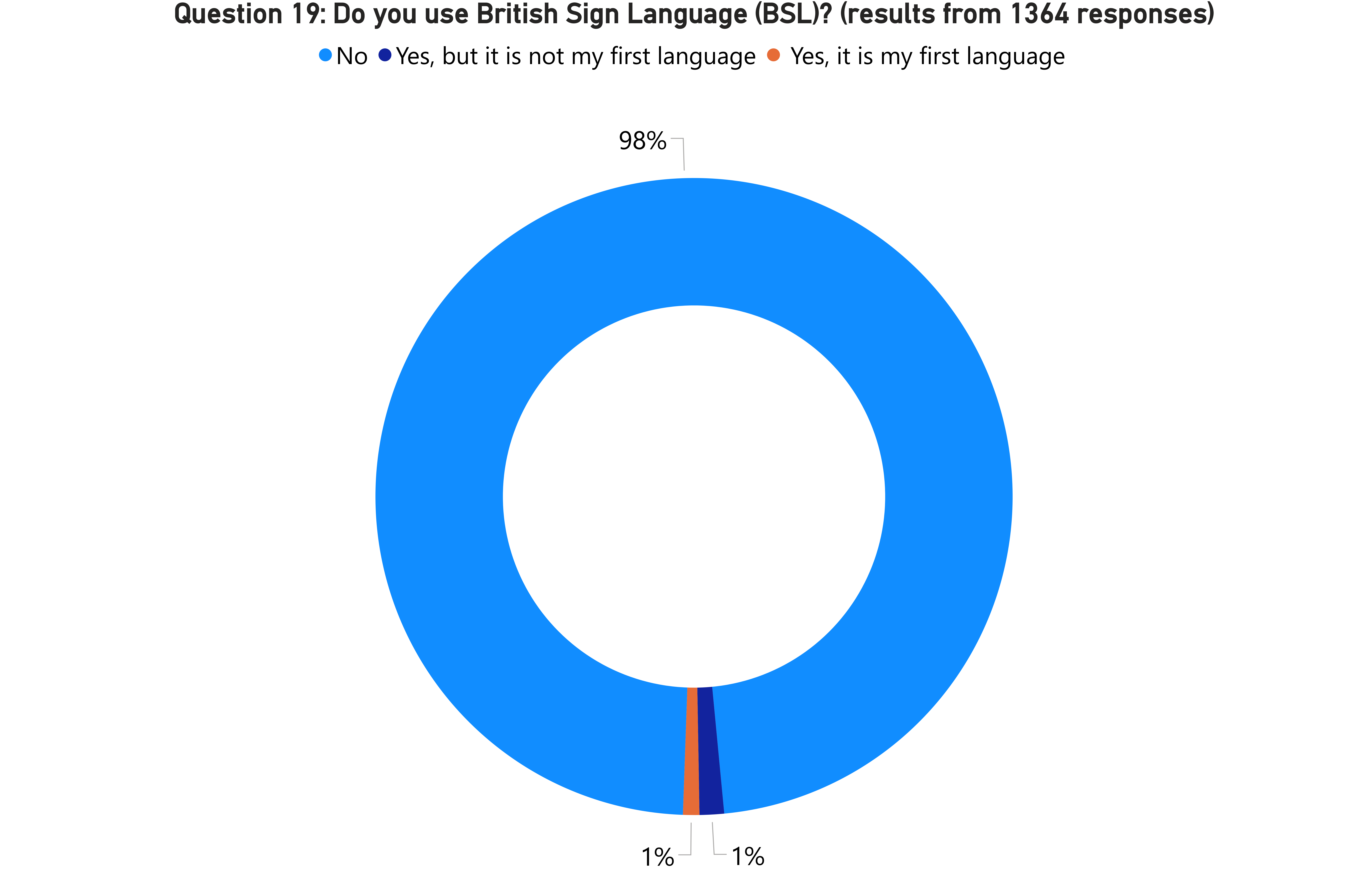
Figure 4.7: Donut chart showing the proportion of respondents who use BSL
Closed Question Analysis: Questions 1 to 5
This section outlines the responses to Questions 1 to 5 of the online feedback survey, which were all fixed multiple choice questions. These questions included how a respondent heard about the consultation, how satisfied they were with the draft Review outcomes and the Refined Package, and what interventions they prioritised within the Refined Package.
Question 1: How did you hear about this round of consultation on the A96 Corridor Review?
Of the 1,404 respondents who answered Question 1, the most common method to hear about the consultation was through a ‘social media post’, at 51%, followed by ‘newspaper/online news’ site at 28% and 8% through ‘word of mouth’. Full results are shown in Figure 4.8 .
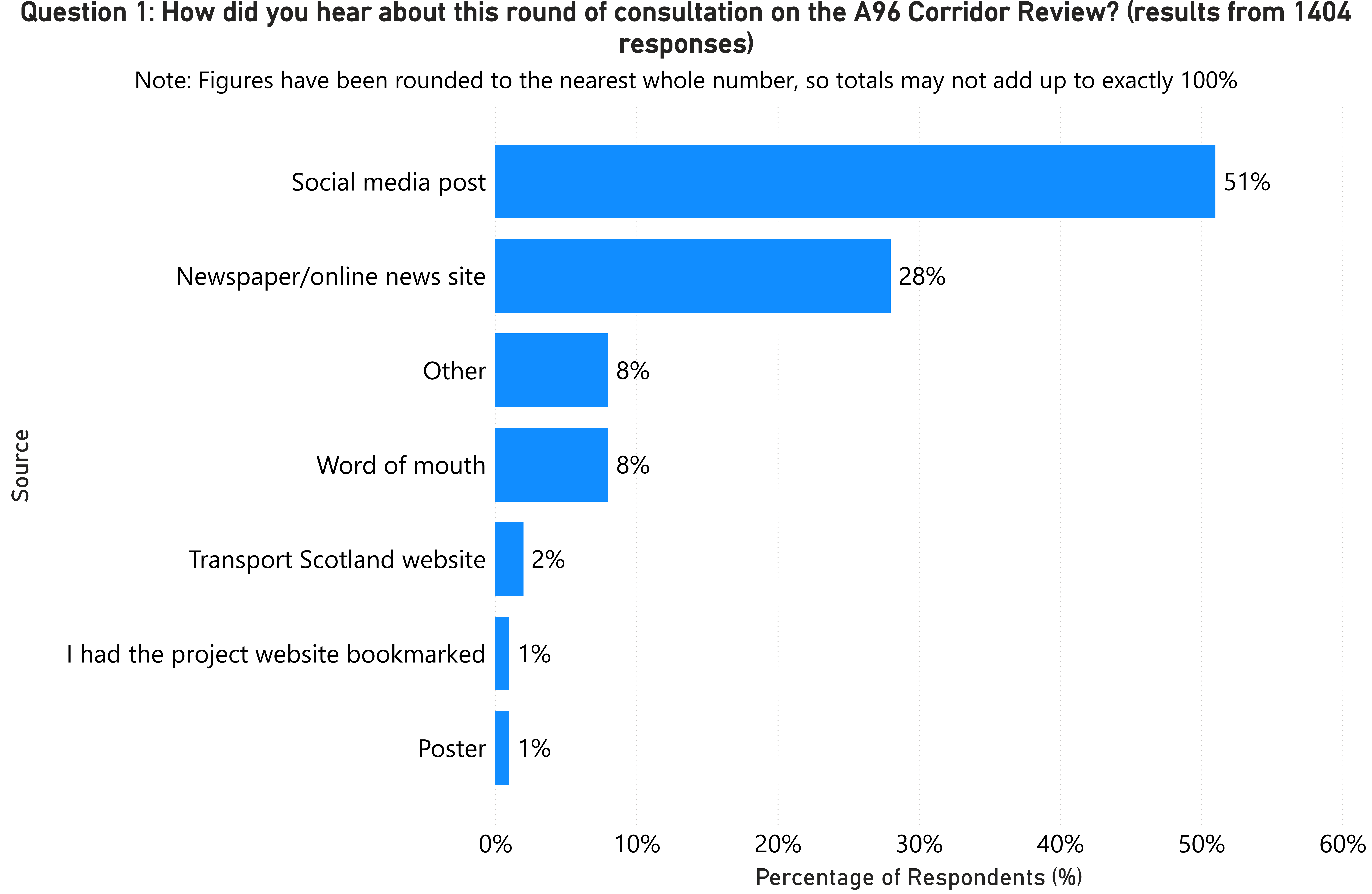
Question 2: To what extent are you satisfied with the outcomes of the A96 Corridor Review?
Respondents were able to rank their satisfaction with the draft outcomes of the Review on a scale from ‘very satisfied’ to ‘very dissatisfied’. Of the 1,398 responses provided to Question 2, 13% were ‘satisfied’ or ‘very satisfied’, 9% were ‘neither satisfied nor dissatisfied’, 76% were ‘dissatisfied’ or ‘very dissatisfied’, and 2% selected ‘did not know/not applicable’. The full results are shown in Figure 4.9 .
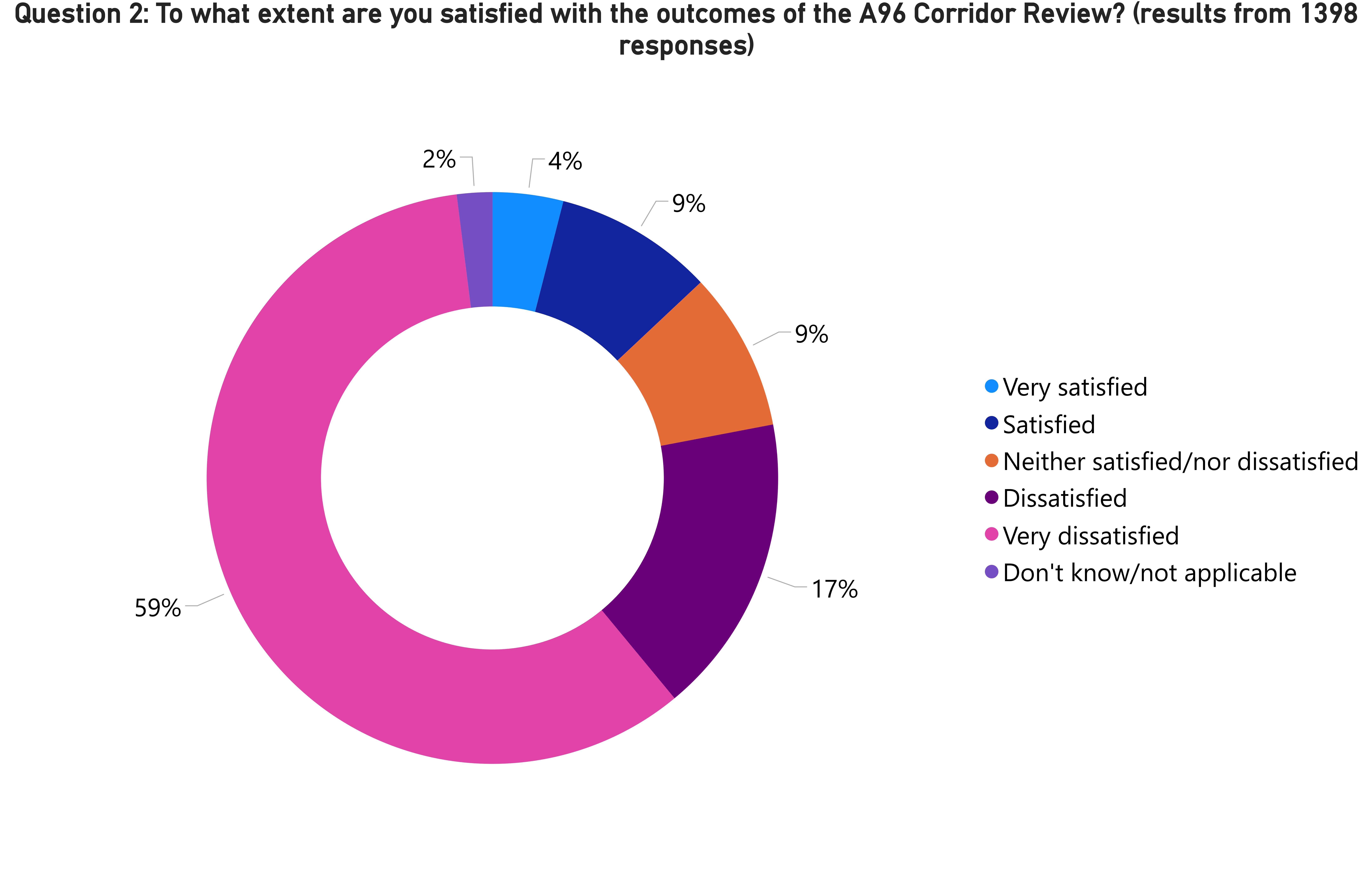
Question 3: How satisfied are you with the Refined Package?
Respondents were asked to rank their satisfaction with the Refined Package on a scale from ‘very satisfied’ to ‘very dissatisfied’. Of the 1,399 responses to Question 3, 13% were ‘satisfied‘ or ‘very satisfied ‘, 9% were ‘neither satisfied nor dissatisfied‘, 74% were ‘dissatisfied‘ or ‘very dissatisfied‘, and 3% selected ‘did not know/not applicable‘. The full results are shown in Figure 4.10.
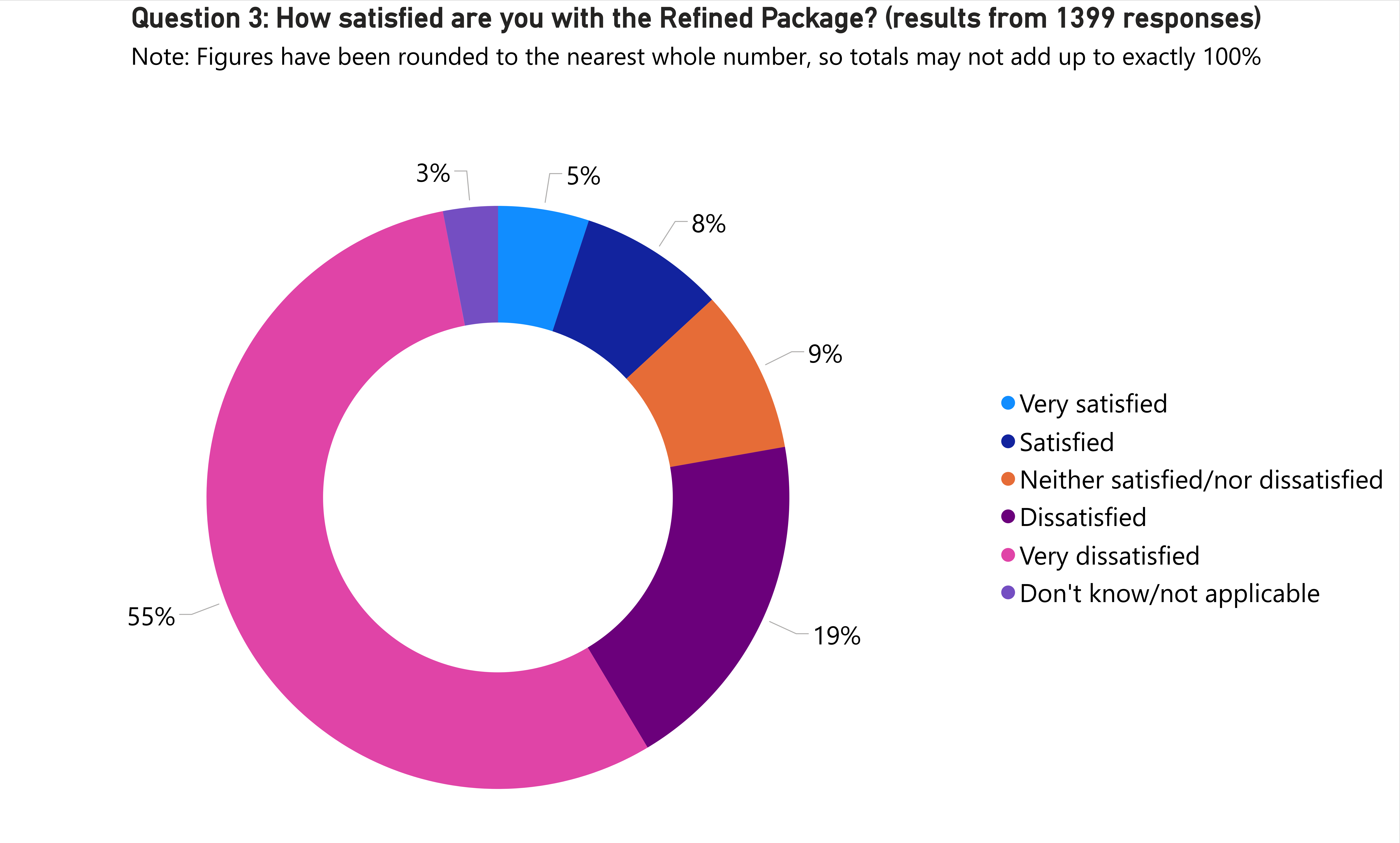
Question 4: What interventions are your priority/priorities within the Refined Package?
Question 4 presented all eight interventions included in the Refined Package, and asked respondents to tick all that they viewed as a priority to addressing the problems and opportunities identified within the A96 corridor. Of the 1,298 respondents to Question 4, 81% and 76% chose the Elgin and Keith bypasses respectively as a priority. Targeted Road Safety Improvements was the next highest priority, selected by 45% of respondents, followed by Linespeed, Passenger and Freight Capacity Improvements on the Aberdeen to Inverness Rail Line at 34%, and Improved Public Transport Passenger Interchange Facilities at 29%.
The full breakdown of results is shown in Figure 4.11 . Please note, the percentages in Figure 4.11 do not add up to 100% as respondents could select multiple interventions as priorities.
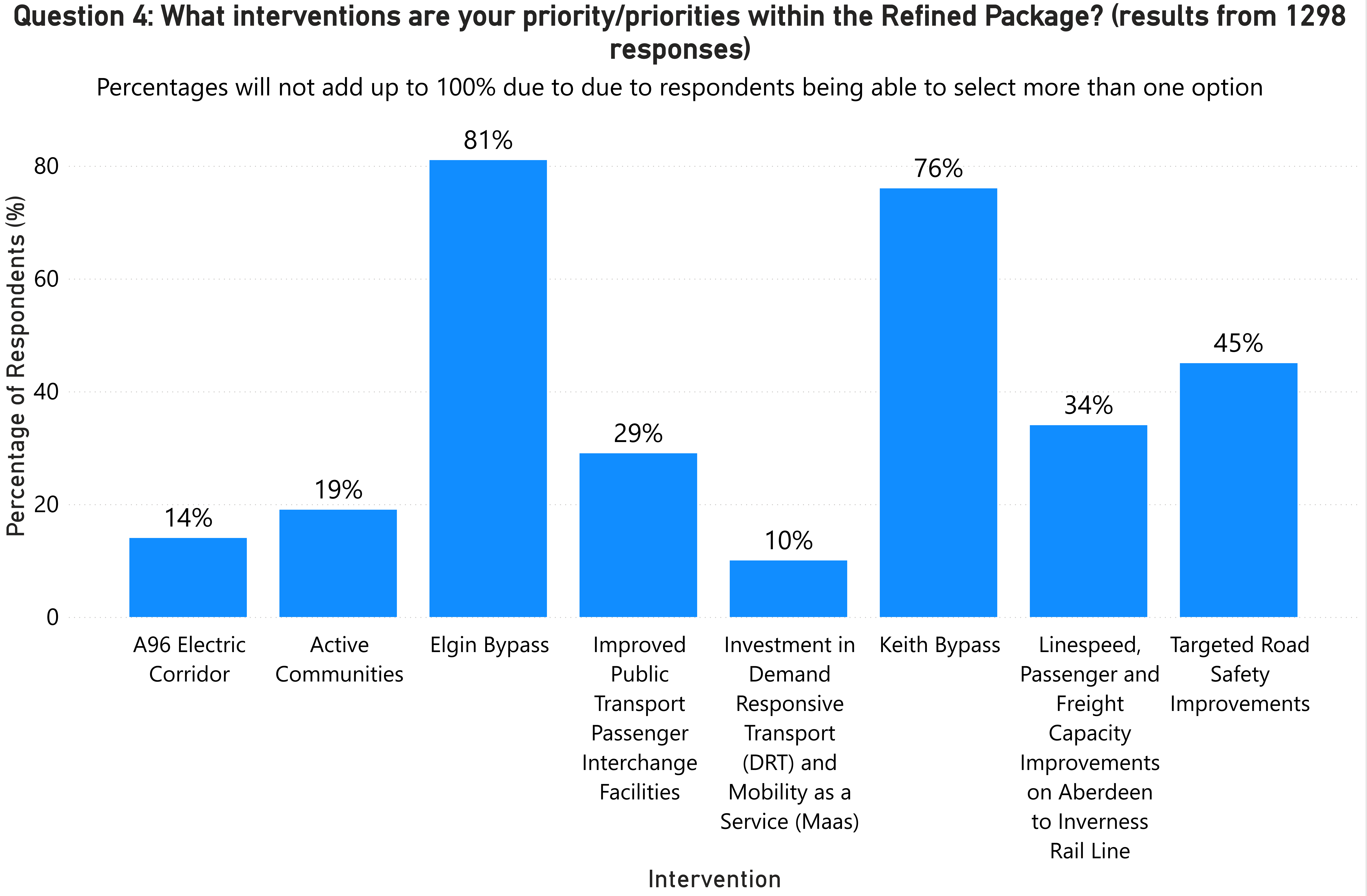
Question 5: Do you feel that the Refined Package will improve your experience of living, working and travelling along the A96 corridor?
Of the 1,396 respondents who opted to answer Question 5, 24% answered ‘yes’, 66% answered ‘no’ and 10% selected ‘do not know/not applicable’, as shown in Figure 4.12 .
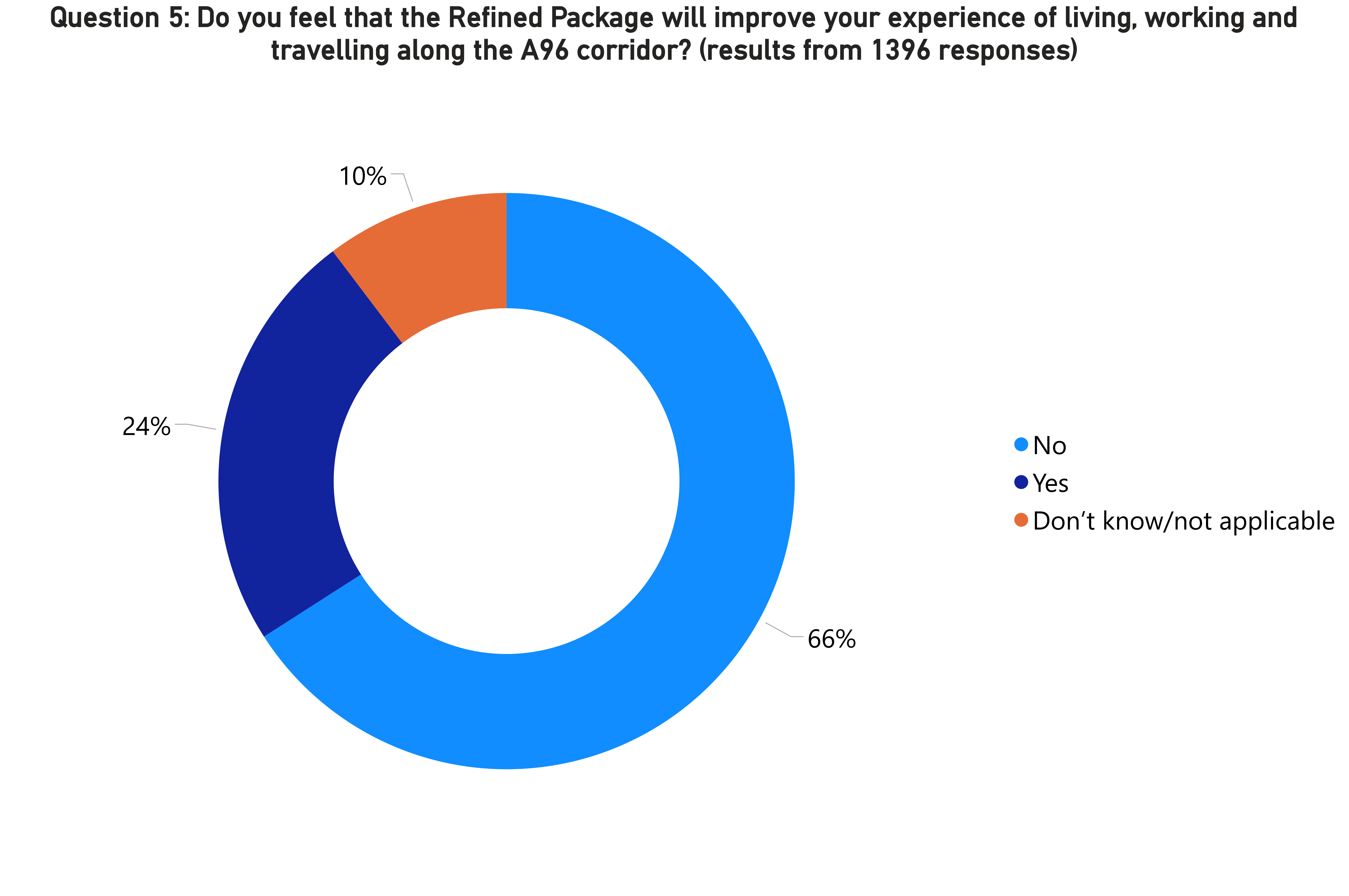
Open Question Analysis
This section summarises the feedback provided for open questions. The open questions (Questions 6-9) provided respondents with the opportunity to type their responses into a blank box rather than select from a list of predefined options or answers. Of the 1,409 responses received via the online feedback survey, five responses from stakeholder groups who attended briefings have had their responses to the open questions extracted and incorporated into the stakeholder feedback reporting in Section 3.2.
As a result, this section provides a detailed summary of the remaining 1,404 online feedback survey responses.
Question 6: Do you have any further comments?
Question 6 provided respondents with the opportunity to expand on their answers to the previous closed questions regarding the Review. Of the 1,409 feedback survey responses received, 1,122 respondents provided responses to Question 6, with 282 opting to leave it blank. The five responses received from stakeholder groups have not been included in the analysis within this section, and can be found in Section 3.2 .
The 1,122 responses were broken down into themes. Figure 4.13 provides a breakdown of the themes identified within responses from all 1122 respondents to Question 6. Values do not add up to 100% due to responses often containing multiple themes. For further information on the definition and list of themes included, please refer to Section 4.2 .
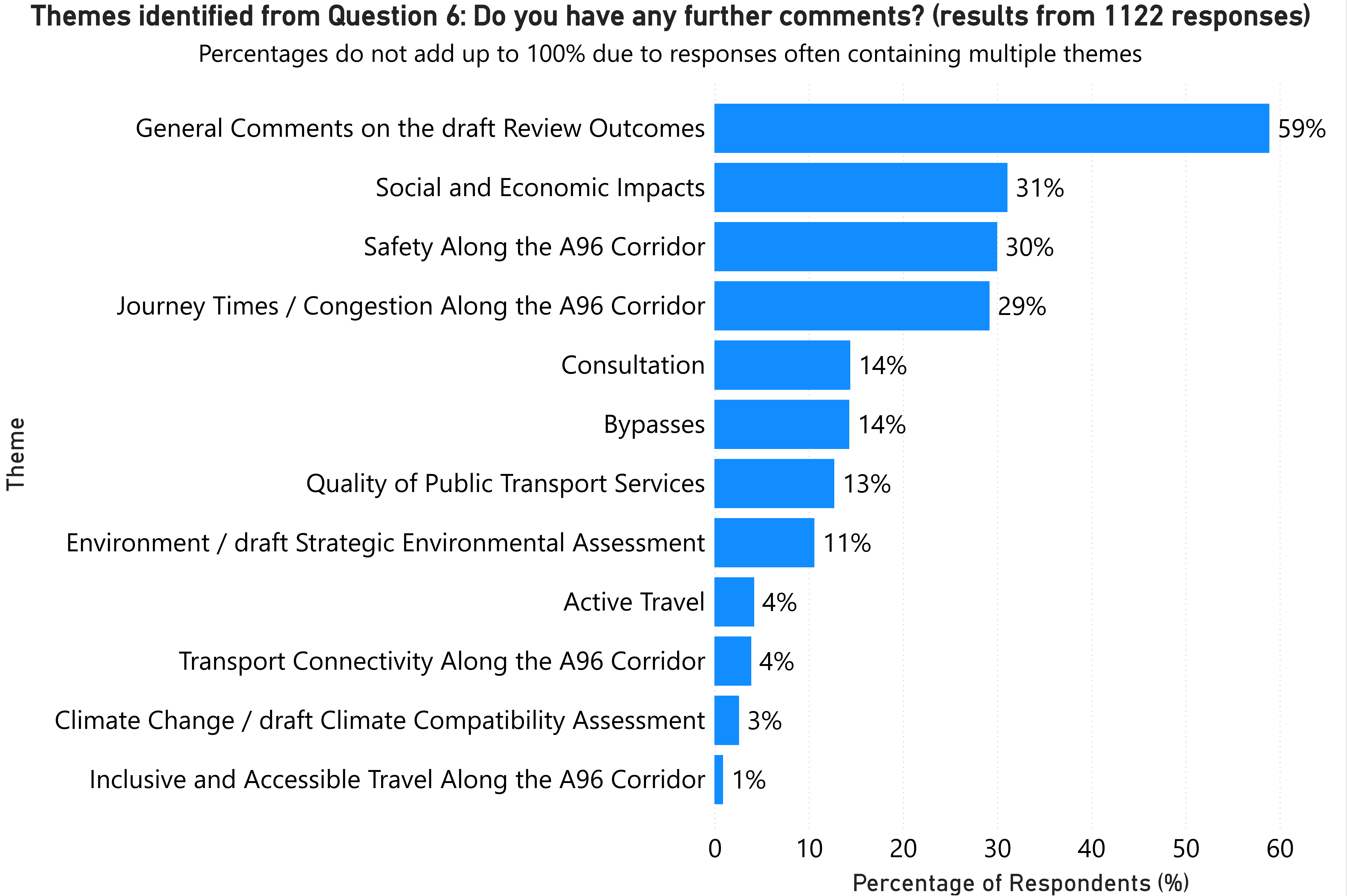
The following section provides a breakdown of open responses to Question 6 within each theme.
General comments on the draft Review outcomes
Of the 1,122 responses received for Question 6, 59% were identified as containing topics under the theme of general comments on the draft Review outcomes. General comments included support or opposition which could not be categorised within specific criteria of the Review such as safety, environment, or climate change. The most common topics identified under this theme for Question 6 are as follows:
428 respondents provided general support for the Scottish Government’s current commitment to fully dual the A96 (excludes comments relating to certain aspects of Full Dualling outperforming the other packages appraised as part of the Review).
101 respondents expressed frustration as to the time taken to undertake the Review, with additional requests for the Review to conclude to allow improvements to commence without further delay.
70 respondents expressed general dissatisfaction with the draft outcomes of the Review, citing opposition to the Refined Package, the impression that the Review’s draft outcomes have resulted in the abandonment of Full Dualling, and their consideration that the draft outcomes of the Review will not solve the problems present within the existing corridor.
28 respondents expressed general opposition to Full Dualling (excludes comments relating to certain aspects of Full Dualling underperforming in comparison to the other packages).
25 respondents stated that they believe that the draft outcomes of the Review will not benefit residents or address the geographical challenges of the north-east of Scotland.
23 respondents raised concern over the validity of the draft outcomes of the Review, including suggestions from respondents that there is a bias to suit a pre-determined outcome, and that the draft outcomes are motivated to save money.
Social and economic impacts
Of the 1,122 responses provided for Question 6, 31% were identified as containing topics under the theme of social and economic impacts of the Review for businesses, growth and the communities along the corridor. The most common topics identified under this theme for Question 6 are as follows:
198 respondents expressed the view that the draft outcomes of the Review represent an example of how the north-east and Highlands are considered to be neglected in comparison with other regions of Scotland.
67 respondents provided support for Full Dualling, commenting that it would deliver greater economic benefits within the corridor compared to the Refined Package. Comments also suggested that Full Dualling would offer stronger support for tourism, improve access to employment, facilitate business travel, and encourage investment along the corridor.
43 respondents commented that the rural landscape of the corridor and long travel distances required to access key amenities results in a heavy reliance on private vehicle usage.
35 respondents noted that modal shift from private vehicle use to public transport is unlikely because of the cost of travel, particularly for train travel.
31 respondents expressed a view that recent regional growth in both development and population are putting the A96 under even more strain, with residential developments in Inverurie and Elgin noted by respondents as concerns for future bottlenecks along the corridor, along with proposed investment in renewable energy sites, including green freeports, which will rely on the A96 corridor to carry materials.
23 respondents expressed opposition to Full Dualling due to its anticipated cost, with suggestions from respondents that the money saved by implementing the Refined Package as an alternative could be spent elsewhere, and that Full Dualling would not provide sufficient benefits to justify the higher cost.
Safety along the A96 corridor
Of the 1,122 responses received for Question 6, 30% were identified as containing topics under the theme of safety along the A96 corridor. This theme references to how the current A96 is perceived as unsafe for road users and impacts to health and safety, along with support for or opposition to the draft Review’s outcomes regarding safety. The most common topics identified under this theme for Question 6 are as follows:
148 respondents provided support for Full Dualling, with respondents expressing their views that it would be most effective at delivering road and commuter safety along the A96 corridor by providing safe overtaking opportunities of slow vehicles that would reduce dangerous driving behaviour.
143 respondents commented on accidents and safety concerns they have on the A96, specifically in Huntly, Elgin, Keith and Nairn. Examples of perceived causes noted included driver frustration, risky overtaking due to congestion and lack of safe opportunities, speeding, and environmental conditions specifically during the winter. Respondents also commented that they believe the Review did not prioritise road and commuter safety highly enough in its draft outcomes.
34 respondents provided support for safe overtaking opportunities, with specifically named locations including, but not limited to, Keith, Elgin, Nairn and Inverurie. Additional targeted road safety improvement requests across the corridor included targeting accident blackspots, with proposals of higher police presence to catch dangerous driving behaviours such as speeding.
26 respondents noted their concern that emergency service vehicles experience potential difficulties accessing patients and other facilities due to perceived congestion resulting in slower response times. Respondent views also included that residents face difficulties accessing healthcare because of slow traffic flow and congestion along the A96. Access to Aberdeen Royal Infirmary for healthcare workers and residents was also raised as a concern, with respondents commenting about extended journey times caused by congestion.
Journey times and congestion along the A96 Corridor
Of the 1,122 responses received for Question 6, 29% were identified as containing topics under the theme of journey times and congestion along the A96 corridor. This theme includes respondent views on the causes and potential solutions for congestion. The most common topics identified under this theme for Question 6 are as follows:
144 respondents provided their views on current causes of traffic and congestion along the A96. The causes raised by respondents included, but are not limited to, slow-moving vehicles (such as heavy goods vehicles, tractors or commercial vehicles) and the view that there is a lack of safe opportunities to overtake them, resulting in large tailbacks. The locations identified by respondents included Aberdeen, Elgin, Forres, Keith, Inverurie, and Nairn.
81 respondents also expressed support for Full Dualling, commenting that this option would be more effective at reducing congestion, delays and journey times along the corridor.
40 respondents made reference to the ongoing Transport Scotland consultation on proposals to reduce the speed limit on single carriageway trunk roads to 50mph. Respondents expressed general opposition to this proposal, stating that if the A96 were to remain a single carriageway road, a reduction in speed limit would be likely to exacerbate the current issues which result in congestion and that most accidents are caused by frustration at slow-moving traffic.
28 respondents requested interventions to tackle congestion, including, but not limited to, partial dualling and additional crawler lanes along the A96.
24 respondents were of the opinion that the draft outcomes of the Review do not sufficiently address the causes of congestion along the corridor. Reasons included that the draft outcomes do not address the current issue of slow drivers along the corridor, resulting in tailbacks due to the lack of overtaking opportunities. Respondents also commented that the uptake of electric and hydrogen powered vehicles will result in an increase in private vehicle use which will exacerbate conditions along the A96.
Consultation
Of the 1,122 responses received for Question 6, 14% were identified as containing topics in relation to the consultation. This theme included views on the adequacy, promotion and methodology of the consultation as part of the Review. The most common topics identified under this theme for Question 6 are as follows:
64 respondents expressed concern over the amount of money spent to undertake the consultation, and their views that the latest consultation was not required.
43 respondents commented that they think the consultation should not delay a final decision any longer, with a small proportion suggesting that there is a bias to suit a preferred outcome, that is, the Scottish Government to drop their current commitment to Full Dualling.
30 respondents expressed the view that the survey questions and feedback channels were inadequate. Specific concerns raised by respondents included questions which limited feedback options and the lack of a specific question which asked respondents to indicate their support for Full Dualling.
15 respondents expressed the view that the consultation process was in support of a predetermined outcome. Respondent views also included the suggestion that feedback from residents and businesses has not been accounted for in the outcomes of the Review.
13 respondents noted that they thought the StoryMap pages and materials were inadequate and inaccessible.
Bypasses
Of the 1,122 responses provided for Question 6, 14% were identified as containing topics in relation to bypasses. This theme included support or opposition to named bypasses and requests for other towns to be bypassed. The most common topics identified under this theme for Question 6 are as follows:
93 respondents provided support for bypasses at Keith and Elgin.
37 respondents did not provide a preference for specific bypasses of named towns, but rather showed general support for bypassing key towns along the corridor.
19 respondents also suggested that bypasses implemented along the corridor should be dualled to allow for safe overtaking, although some respondents stated that they should not be considered an alternative to Full Dualling.
18 respondents provided support for bypasses not included in the Refined Package, commenting that that these should be reconsidered for inclusion. Inverurie received the most from these respondents due to growth around the town, with references also made to Huntly, Kintore, Forres and Oldmeldrum.
Quality of public transport services
Of the 1,122 responses provided for Question 6, 13% were identified as containing topics in relation to interventions which seek to improve the quality of public transport along the corridor. The most common topics identified under this theme for Question 6 are as follows:
78 respondents commented that journey times for public transport are too long, and that reliability of the services is too poor for them to be considered a viable alternative to car travel. Locations mentioned by respondents included, but were not limited to, Elgin, Inverness, Huntly, Inverurie, Keith and Aberdeen.
67 respondents provided their support for public transport improvements, with suggestions including, but not limited to, electrification and dualling of the rail lines, fare price reductions, and increasing service frequency and areas serviced by both rail and bus. Specific locations and lines mentioned by respondents included the Highland Main Line, the Aberdeen to Inverness line, Dyce and Aberdeen airports, and Inverurie. It should be noted that this feedback was split between respondents who requested interventions alongside Full Dualling, and others who supported interventions included within the Refined Package.
14 respondents who referenced public transport were of the opinion that current measures in the Refined Package to improve public transport are not sufficient. The reasons cited by respondents included the omission of a commitment to dual the rail lines, that public transport improvements are considered to only benefit a proportion of residents and that they will not improve conditions on the roads.
Environment/draft Strategic Environmental Assessment
Of the 1,122 responses provided for Question 6, 11% were identified as containing topics under the theme of environment and the draft SEA. The most common topics identified under this theme for Question 6 are as follows:
29 respondents provided support for Full Dualling as it was considered that it would provide environmental benefits. Respondent views also included the suggestions that dualling would improve traffic flow, therefore making journeys more fuel efficient, and encouraging the uptake of electric and other alternatively fuelled vehicles, thereby encouraging more low-emission travel along the A96.
27 respondents expressed their view that Full Dualling would have a negative impact on the environment. Concerns raised included Full Dualling’s incompatibility with national environmental and climate targets and concerns about the impact on agricultural land, historical sites and the landscape.
25 respondents expressed dissatisfaction with the weighting of the Review’s criteria, stating bias towards environmental impacts over other criteria. Some respondents stated that they would have preferred more weighting towards safety and economy criteria.
20 respondents expressed support for reducing pollution and improving air quality in town centres as a priority. Some respondents noted the health risks associated with congested town centres for vulnerable residents, with support for removing traffic from town centres as a way of combatting this.
11 respondents commented that they thought the outcomes of the Review do not adequately account for the current emissions caused by poor traffic flow along the A96 and the impact of this. Respondents also expressed more general scepticism about the outcomes of the draft Strategic Environmental Assessment, including suggestions that it does not adequately account for the future uptake of electric vehicles, which would mitigate the environmental impact of Full Dualling.
Active travel
Of the 1,122 responses provided for Question 6, 4% were identified as containing topics in relation to the Active Communities intervention within the Refined Package and any other active travel suggestions or references. The most common topics identified under this theme for Question 6 are as follows:
15 respondents commented that active travel interventions, in some cases specifically the Active Communities intervention included within the Refined Package, would not benefit the majority of those travelling along the A96. Reasons cited by respondents included the length of their commutes and because certain residents, such as the elderly, would not benefit from this intervention.
11 respondents expressed support for the current Active Communities intervention in the Refined Package, along with support for wider active travel prioritisation along the corridor not included within the Refined Package.
Seven respondents expressed their support for an increase in cycling infrastructure, particularly new corridor-wide cycle paths.
Transport Connectivity Along the A96 Corridor
Of the 1,122 responses provided for Question 6, 4% were identified as containing topics in relation to transport connectivity along the A96 corridor. This theme included comments about the connectivity between towns and settlements. The most common topics identified under this theme for Question 6 are as follows:
21 respondents provided support for Full Dualling, suggesting that it would be most effective at increasing connectivity and access between towns, settlements and services. Some respondents expressed the view that connectivity is a key factor for future economic prosperity along the corridor.
14 respondents expressed concern regarding the current standard of route connectivity via public transport. Respondents noted their views on certain communities experiencing severance from the public transport network as they are not well serviced, specifically mentioning Huntly to Aberdeen and Dyce, Elgin and Keith.
Climate change/draft Climate Compatibility Assessment
Of the 1,122 responses provided for Question 6, 3% were identified as containing topics in relation to climate change policy, interventions within the Refined Package which seek to address climate change challenges, and references to the draft Climate Compatibility Assessment. The most common topics identified under this theme for Question 6 are as follows:
11 respondents provided support for the Review’s aim to address the challenges of climate change, including requests that all interventions should aim to deliver reduced carbon emissions and the opinion that road building during a climate crisis is inappropriate. Some respondents also provided support for the Electric Corridor intervention in the Refined Package.
Nine respondents suggested that the Electric Corridor intervention within the Refined Package would be unsuitable for the A96, with some adding the view that it should not be prioritised over other interventions targeting public transport or active travel.
Six respondents provided the opposite opinion, and expressed support for the Electric Corridor intervention within the Refined Package.
Inclusive and accessible travel along the A96 corridor
Of the 1,122 responses provided for Question 6, 1% was identified as containing topics in relation to current accessibility barriers to travel along the corridor, along with any support or suggestions for creating more inclusive and accessible travel along the corridor. The most common topics identified under this theme for Question 6 is as follows:
Eight respondents suggested that a lack of accessible alternative modes of travel has resulted in a reliance on private vehicles along the corridor. Feedback from respondents included views on community isolation from services such as rail stations and bus services. Additionally, the train station at Insch was mentioned by respondents as being inaccessible for wheelchair users or those with prams/buggies.
Question 7: Please note here any comments you wish to make on the overall findings of the Draft Strategic Environmental Assessment for the A96 Corridor Review
Question 7 provided respondents with the opportunity to provide further comments on the draft Strategic Environment Assessment (SEA), which was published as part of the Review. Of the 1,409 online feedback survey responses received, 620 respondents chose to answer this question, with 784 opting to leave it blank. The five responses received from stakeholder groups are not included in the analysis in this section, and are instead summarised in Section 3.2
The 620 responses were broken down into themes, Figure 4.14 shows a breakdown of the themes identified. Values do not add up to 100% due to responses often containing multiple themes. For further information on the definition and list of themes included, please refer to Section 4.2 .
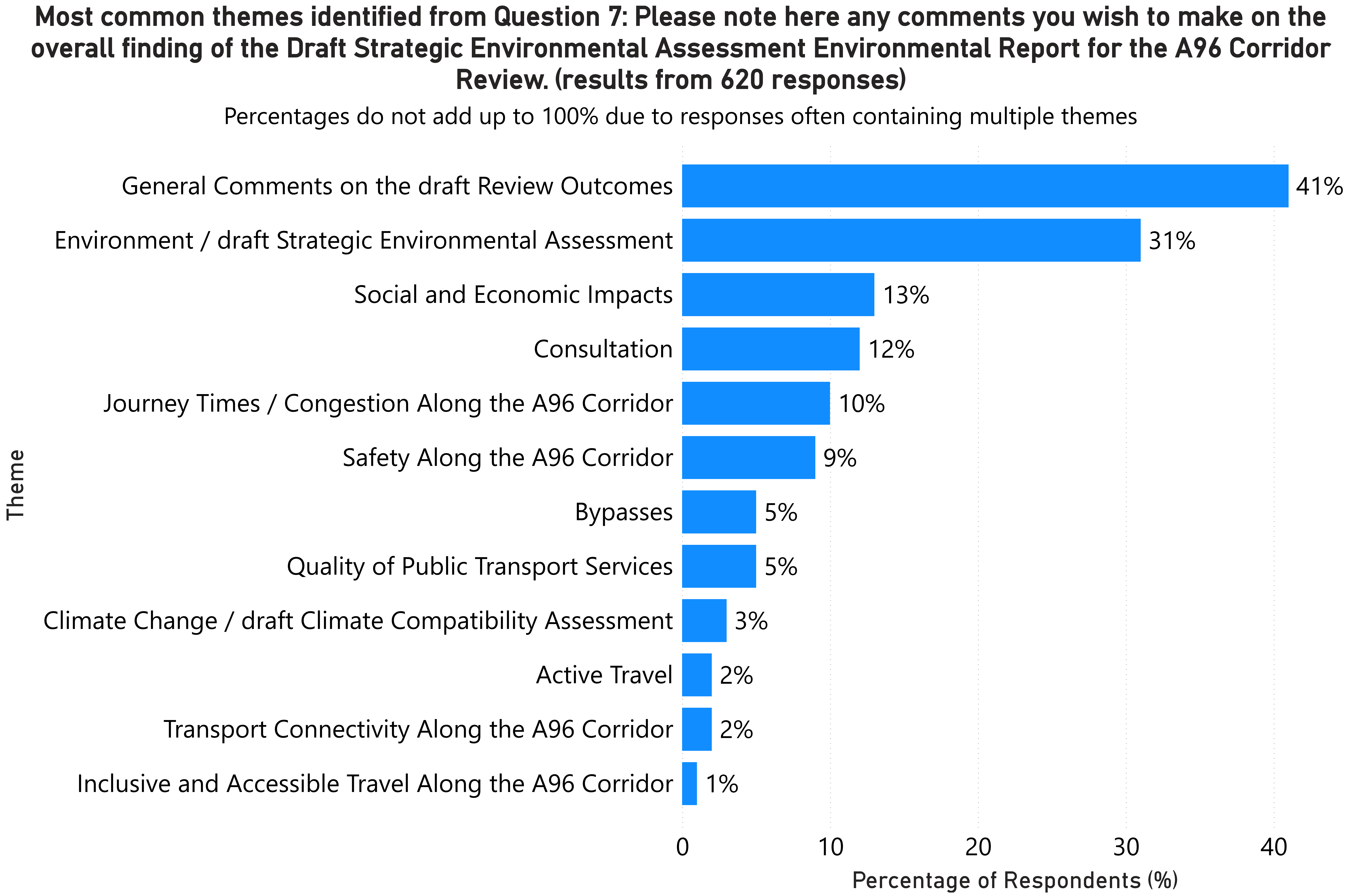
The following section provides a breakdown of the most common topics identified in responses to Question 7 within each theme.
General comments on the draft Review outcomes
Of the 620 responses received for Question 7, 41% were identified as containing topics under the theme of general comments on the draft Review outcomes. General comments included support or opposition which could not be categorised within specific criteria of the Review such as safety, environment, or climate change. The most common topics identified under this theme for Question 7 are as follows:
94 respondents expressed general support for the Scottish Government’s current commitment to fully dual the A96.
52 respondents expressed general dissatisfaction with the draft outcomes of the Review. Respondent views also included suggestions that there is a bias to suit a pre-determined outcome, that the outcomes are motivated to save money, and their belief that they would not benefit the residents and communities along the corridor.
48 respondents also expressed frustration as to the time taken to undertake the Review, with additional requests for the Review to conclude to allow improvements to commence without further delay.
19 respondents provided general support for the Review and its draft outcomes.
Eight respondents expressed general opposition to Full Dualling, respondent views also included suggestions that Full Dualling would be a waste of resources, that we do not need more roads and that the infrastructure available should be reused.
Environment/draft Strategic Environmental Assessment
Of the 620 responses received for Question 7, 31% were identified as containing topics under the theme of environment and the draft SEA. The most common topics identified under this theme for Question 7 are as follows:
55 respondents expressed scepticism about the outcomes of the draft SEA. Respondent views also included the suggestion that the draft SEA does not adequately account for the future uptake of electric vehicles which they consider would mitigate the environmental impact of Full Dualling.
53 respondents expressed their dissatisfaction with the weighting of the Review’s criteria. Respondents commented that they considered the appraisal criteria leans heavily towards environmental impacts over other criteria such as safety and supporting regional economic growth.
26 respondents commented that they consider Full Dualling would have too negative an impact on the environment. Concerns raised from respondents included the suggestion that Full Dualling is considered incompatible with national environmental and climate targets, that it would require too much agricultural land to construct and degrade the local environment.
22 respondents provided support for Full Dualling, suggesting that it would provide sufficient environmental benefits. Respondents comments also included that benefits would include encouraging the uptake of electric and alternatively fuelled vehicles, improving traffic flow and therefore reducing air pollution.
19 respondents expressed support for the incorporation of environmental mitigation into the draft outcomes of the Review, with the suggestion of priorities such as preserving biodiversity and wildlife, prioritisation of noise mitigation and the protection of agricultural land.
Social and economic impacts
Of the 620 responses received for Question 7, 13% were identified as containing topics under the theme of social and economic impacts. Social and economic impacts included respondent views on the impact of the Review for businesses, growth and the communities along the corridor. An overview of the most common topics identified under this theme are as follows:
29 respondents expressed the view that the draft outcomes of the Review represent an example of how the north-east and Highlands are considered to be neglected in comparison with other regions of Scotland. Respondents also commented that they consider environmental impacts are more heavily scrutinised for schemes in their region than elsewhere, and that the draft outcomes of the Review are preventing regional economic growth.
16 respondents expressed their support for Full Dualling, due to their views that it would provide greater economic benefits to the region through better access to employment, facilitate easier travel for businesses to operate and reduce transport costs for businesses. Respondents also suggested that they considered Full Dualling would attract investment to the region and would support the growth of renewable infrastructure and tourism.
13 respondents commented that the rural landscape of the corridor and long travel distances required to access key amenities results in a heavy reliance on private vehicle usage.
Nine respondents raised their concern over the cost of public transport as compared to the use of private car and expressed scepticism over the feasibility of shifting to public transport.
Eight respondents expressed their opposition to Full Dualling, including commenting on its anticipated cost, and provided their support for the Refined Package either as a whole, or for specific interventions which they considered most critical and could be implemented at a lower cost. Priorities cited by respondents included the bypasses of Keith and Elgin as well as Targeted Road Safety Improvements.
Consultation
Of the 620 responses received for Question 7, 12% were identified as containing topics under the theme of consultation. The most common topics identified under this theme for Question 7 are as follows:
40 respondents raised concerns over the amount of money spent to undertake the consultation, and their views that this money would have been better spent on the implementation of the interventions along the A96.
13 respondents stated that the consultation should not delay a decision being made on how transport interventions for the corridor will be taken forward.
Ten respondents expressed their view that the consultation supported a pre-determined outcome. Respondent views also included that the consultation will not result in a decision being made, and that the feedback of the public and local businesses had not been considered sufficiently.
Eight respondents commented that it was unclear in the consultation materials where to find the draft SEA, and that the terminology used across the reports was too difficult to understand. Respondent views also included that the survey questions were considered inadequate, with specific criticisms expressed regarding the lack of a specific question on support for Full Dualling.
Journey times/congestion along the A96 corridor
Of the 620 responses received for Question 7, 10% were identified as containing topics under the theme of journey times and congestion on the A96. This theme includes respondent views on the causes and potential solutions for congestion. The most common topics identified under this theme for Question 7 are as follows:
- 17 respondents commented on issues they believed to be causing traffic and congestion on the A96. The issues raised by respondents included, but were not limited to, the physical condition of the road which they consider is not fit for purpose, and an observed increase in the volume of traffic travelling along the A96 particularly around Nairn and Inverurie.
14 respondents stated support for Full Dualling, commenting that this option would be considered more effective at reducing congestion, delays and journey times along the corridor. Respondents expressed the view that a smoother flow of traffic would result in drivers using less fuel and reduce emissions, as well as reduce driver frustration.
14 respondents were of the opinion that the draft outcomes of the Review do not sufficiently address the causes of congestion along the corridor. Respondents further suggested that the future uptake of electric and alternatively fuelled vehicles would result in the A96, without being dualled, still experiencing heavy congestion, with locations between Nairn and Elgin, and Elgin to Fochabers identified.
Six respondents proposed interventions not included in the draft outcomes of the Review which they consider could reduce congestion and in some cases facilitate environmental mitigation. The proposals raised included, but were not limited to, widening the existing road and the introduction of additional crawler lanes.
Five respondents made reference to the Transport Scotland consultation on proposals to reduce the speed limit on single carriage trunk roads to 50mph, which was ongoing at the time of the A96 Corridor Review consultation. Respondents expressed their opinion that the proposals would negatively impact on the current conditions of the A96.
Safety along the A96 corridor
Of the 620 responses received for Question 7, 9% were identified as containing topics under the theme of safety along the A96 corridor. The most common topics identified under this theme for Question 7 are as follows:
25 respondents provided support for Full Dualling, expressing the view that it would be most effective at delivering improved road safety for commuters along the A96. Justifications provided for this included that dualling would provide safe overtaking opportunities and reduce driver frustration which leads to accidents.
15 respondents expressed their views on the adequacy of the Review’s draft outcomes at addressing road safety and the priority of safety over environmental mitigation or cost. Additional measures suggested by respondents included additional safe overtaking opportunities, and reducing the speed limit along the corridor.
13 respondents raised accidents and safety concerns, noting their views on speeding and unsafe overtaking due to driver frustration.
Quality of public transport services
Of the 620 responses provided received for Question 7, 5% were identified as containing topics under the theme of quality of public transport services. The most common topics identified under this theme for Question 7 are as follows:
19 respondents expressed their frustration regarding lengthy journey times, lack of public transport in certain areas and low reliability of the public transport services resulting in dependence on car travel.
16 respondents stated support for public transport improvements, with suggestions raised including the reinstatement of discontinued rail lines, reducing the journey time for rail services from Inverness to Aberdeen to 1.5 hours and double tracking the rail lines along the corridor.
Bypasses
Of the 620 responses received for Question 7, 5% were identified as containing topics under the theme of bypasses. The most common topics identified under this theme for Question 7 are as follows:
15 respondents stated their support for Keith and Elgin bypasses along with Full Dualling.
Eight respondents expressed their views for supporting the bypassing of towns across the A96 corridor without providing a preference for a specific location.
Four respondents expressed the view that they consider bypass interventions are not an alternative to Full Dualling, affirming their support for bypasses being implemented alongside dualling.
Climate change/Draft Climate Compatibility Assessment
Of the 620 responses received for Question 7, 3% were identified as containing topics under the theme of climate change or the draft Climate Compatibility Assessment (CCA). The most common topics identified under this theme for Question 7 are as follows:
Seven respondents expressed their support for the Review’s aims to address the challenges of climate change.
Five respondents expressed opposition to the Review’s aims of addressing climate change.
Active travel
Of the 620 responses received for Question 7, 2% were identified as containing topics under the theme of active travel. The most common topics identified under this theme for Question 7 are as follows:
Seven respondents expressed the view that the proposed active travel interventions would not benefit the majority of commuters along the A96, particularly the elderly.
Four respondents noted their views on active travel, including support for the proposed Active Communities intervention in the Refined Package, along with support for wider active travel prioritisation along the corridor, particularly new cycle paths, and safer crossings of the River Don.
Transport connectivity along the A96 corridor
Of the 620 responses received for Question 7, 2% were identified as containing topics under the theme of transport connectivity along the A96 corridor. The most common topics identified under this theme for Question 7 are as follows:
Four respondents requested greater connectivity between towns for residents and expressed concern regarding the current standard of route connectivity via public transport.
- Three respondents stated support for Full Dualling, commenting that they consider that it would be most effective at increasing connectivity and access between towns, settlements and services.
Inclusive and accessible travel along the A96 corridor
Of the 620 responses received for Question 7, 1% was identified as containing topics under the theme of inclusive and accessible travel along the A96 corridor. An overview of the most common topics identified under this theme are as:
Two respondents expressed their view that reliance on private vehicles is partially due to the distance from accessible alternatives and difficulty in travelling to access services further away from their place of residence.
Two respondents noted support for investment into making transport more accessible along the corridor, specifically noting the introduction of Demand Responsive Transport as a complimentary service for those who are not well served by fixed-route services.
Question 8: Are there any particular environmental issues, problems or opportunities you would like to mention that you feel have not been captured within the Draft Strategic Environmental Assessment (SEA)?
Question 8 provided respondents with an opportunity to comment on any environmental issues, problems or opportunities they felt were omitted within the draft SEA outcomes. Of the 1,409 feedback form responses received, 513 respondents opted to provide a response to this question, with 891 respondents opting to leave it blank. The five responses received from stakeholder groups have not been included in the analysis within this section, and can be found in Section 3.2.
The 513 responses received were broken down into themes, Figure 4.15 providing a breakdown of the themes identified within the responses to Question 8. Values do not add up to 100% due to responses often containing multiple themes. For further information on the definition and list of themes included, please refer to Section 4.2.

The following section provides a breakdown of the most common topics identified in responses to Question 8 within each theme.
Environment/draft Strategic Environmental Assessment
Of the 513 responses received for Question 8, 33% were identified as containing topics under the theme of environment and the draft SEA. The most common topics identified under this theme for Question 8 are as follows:
49 respondents suggested that the draft outcomes of the Review do not sufficiently account for the emissions caused by slow traffic flow along the A96. Respondent views also included that stop-start traffic burns more fuel and creates more pollution, noting several locations they consider to be hotspots, such as Nairn, Elgin, Keith and Inverurie.
34 respondents stated support for Full Dualling, considering it a way of mitigating the current environmental impacts of the A96 corridor. Respondent views also included that they consider Full Dualling would improve traffic flow, leading to more fuel efficient journeys, and that it would encourage the uptake of electric and other alternatively fuelled vehicles along the A96.
28 respondents expressed scepticism about the outcomes of the draft SEA, commenting that the draft SEA does not adequately account for the future uptake of electric vehicles which they consider would mitigate the environmental impact of Full Dualling. Respondent views also included the suggestion that the draft outcomes were based upon an unrealistic assumption of modal shift in travel behaviours for residents.
23 respondents expressed dissatisfaction with the weighting of the Review’s criteria. Respondents commented that they considered the appraisal criteria lean heavily towards environmental impacts and their view that weighting should favour safety and economic growth.
20 respondents commented that they consider Full Dualling would have a negative impact on the environment, expressing their view on its incompatibility with national environmental targets and the amount of agricultural land and woodland which would be required.
15 respondents expressed support for incorporating environmental mitigation into the draft outcomes of the Review, with suggestions of priorities including the preservation of biodiversity and wildlife, flood mitigation, protecting areas of natural beauty and reducing pollution in town centres.
General comments on the draft Review outcomes
Of the 513 responses received for Question 8, 19% were identified as containing topics under the theme of general comments on draft Review outcomes. General comments included support or opposition which could not be categorised within specific criteria of the Review such as safety, environment, or climate change. The most common topics identified under this theme for Question 8 are as follows:
42 respondents expressed their support for the Scottish Government’s current commitment to fully dual the A96.
17 respondents expressed general dissatisfaction with the draft outcomes of the Review. Respondent views also included critiques over the necessity of a draft SEA and the time taken for publication of the report.
Eight respondents expressed general support for the Review, including views that the Review’s criteria were comprehensive, and general content with the appraisals of the Refined Package and Full Dualling against these criteria.
Six respondents provided criticism of the wider Review outcomes which included suggestions from respondents that there is a bias to justify cancelling the commitment to fully dual the road.
Journey times and congestion along the A96 corridor
Of the 513 responses received for Question 8, 11% were identified as containing topics under the theme of journey times and congestion along the A96 corridor. This theme includes respondent views on the causes and potential solutions for congestion. The most common topics identified under this theme for Question 8 are as follows:
22 respondents stated their view on issues they believed to be causing traffic and congestion along the A96. The issues raised by respondents included the prevalence of slow-moving vehicles resulting in tailbacks, and an increase in goods and vehicles travelling along the A96, such as vehicles carrying wind turbines and generators. Common specific locations referenced by respondents included Nairn and Keith.
12 respondents stated support for Full Dualling as they considered that it would be more effective at reducing congestion, delays and journey times along the corridor.
Ten respondents requested proposed interventions not included in the draft outcomes of the Review, which they believed would help reduce congestion and aid environmental mitigation. The proposals included the removal of roundabouts in place of overbridges, congestion charges to discourage road use and encourage modal shift to improved public transport services, and the introduction of speed cameras. Locations mentioned by respondents included Inverurie, Nairn, Meldrum, Aberdeen and Rothienorman.
Eight respondents were of the opinion that the draft outcomes of the Review do not address journey times and congestion adequately. Respondents further commented on their view that without dualling the road, heavy congestion would be experienced due to the potential future uptake of electric and alternatively fuelled vehicles.
Safety along the A96 corridor
Of the 513 responses received for Question 8, 9% were identified as containing topics under the theme of safety along the A96 corridor. The most common topics identified under this theme for Question 8 are as follows:
12 respondents stated support for Full Dualling, expressing the view that it would be most effective at delivering improved road safety for commuters and would provide safe overtaking opportunities.
11 respondents expressed their views on the adequacy of the Review’s draft outcomes at addressing road safety to benefit communities and the priority of safety over environmental mitigation or cost.
Eight respondents commented on their view that Full Dualling would provide better air quality for vulnerable people living in towns along the corridor by removing traffic from town centres.
Seven respondents raised accidents and safety concerns, noting their views on speeding and unsafe overtaking due to driver frustration.
Social and economic impacts
Of the 513 responses received for Question 8, 8% were identified as containing topics under the theme of social and economic impacts. The most common topics identified under this theme for Question 8 are as follows:
Ten respondents expressed their view that the draft outcomes of the Review represent an example of how the north-east and Highlands are considered to be neglected in comparison with other regions of Scotland. Respondents commented that they consider environmental impacts are more heavily scrutinised for schemes in their region, and that the draft outcomes of the Review are preventing economic growth.
Eight respondents expressed their support for Full Dualling due to their views that it would provide greater economic benefits to the region, facilitate regional growth through better access to employment and would attract investment to support the growth of the renewable energy sector.
Six respondents commented that the rural landscape of the corridor and long travel distances required to access key amenities results in a heavy reliance on private vehicle usage.
Four respondents noted their support for removing freight travel off roads and onto rail services.
Quality of public transport services
Of the 513 responses received for Question 8, 5% were identified as containing topics under the theme of quality of public transport services. The most common topics identified under this theme for Question 8 are as follows:
13 respondents stated their support for public transport improvements, with suggestions raised including investment in rail services, signage and the extension of the existing rail network to Aberdeen airport. Specific locations mentioned by respondents included Forres and Fraserburgh via Ellon.
11 respondents also expressed their frustration regarding the reliability of public transport and lengthy journey times resulting in dependence on car travel. Respondents stated their view on the inability of rail services in accommodating current demand, and suggested double tracking the rail.
Four respondents commented on the Refined package in improving public transport. Respondents expressed their views on the lack of access to services across the corridor, as well as suggesting the railway line from Inverness to Aberdeen should be twin tracked.
Climate change/draft Climate Compatibility Assessment
Of the 513 responses received for Question 8, 4% were identified as including topics under the theme of climate change or the draft Climate Compatibility Assessment (CCA). The most common topics identified under this theme for Question 8 are as follows:
Five respondents expressed their opposition to the proposed Electric Corridor intervention due to their views on the unsustainability of electric vehicle battery production.
Five respondents stated their support for the proposed Electric Corridor intervention, with respondent views also including the suggestion that the transition to alternative fuelled vehicles such as electric and hydrogen power has to be supported through building new infrastructure
Four respondents expressed their opposition to the Scottish Government’s initiatives toward achieving net zero.
Consultation
Of the 513 responses to Question 8, 4% were identified as including topics under the theme of consultation. The most common topics identified under this theme for Question 8 are as follows:
Five respondents expressed the opinion that the consultation was biased to suit a pre-determined outcome. Respondents also raised views that the feedback of the public and local businesses had not been considered.
Five respondents expressed the opinion that the consultation materials did not make it clear where they could find the draft Strategic Environmental Assessment for review, and that the survey questions were not relevant to the upgrade of the A96.
Four respondents expressed their concern over the amount of money spent to undertake the consultation.
Active travel
Of the 513 responses provided for Question 8, 3% were identified as including topics under the theme of active travel. The most common topics identified under this theme for Question 8 are as follows:
Six respondents stated their support for the proposed Active Communities intervention in the Refined Package. Support was also noted for general investment into active travel infrastructure along the corridor, specifically requests for improvements to cycle paths and cycle hire infrastructure along the corridor.
Four respondents opposed the proposed Active Communities intervention and wider active travel measures as they suggested that the interventions would not be beneficial to all residents along the corridor.
Bypasses
Of the 513 responses provided for Question 8, 3% were identified as including topics under the theme of bypasses. An overview of the most common topics identified under this theme are as follows:
Eight respondents stated their support for the bypasses of Elgin and Keith.
Three respondents proposed bypasses for towns not included in the Refined Package, such as Inverurie and Forres, commenting that in their opinion these locations are prone to congestion.
Three respondents expressed their views in support for the bypassing of key towns across the corridor, without reference to a specific location.
Transport connectivity along the A96 corridor
Of the 513 responses provided for Question 8, 1% was identified as including topics under the theme of transport connectivity along the A96 corridor. The most common topic identified under this theme for Question 8 is as follows:
Two respondents expressed their concern regarding the current standard of route connectivity via public transport. Respondents also commented that in their view the Refined Package does not adequately address these issues.
Inclusive and accessible travel along the A96 corridor
Of the 513 responses provided for Question 8, less than 1% was identified as including topics under the theme of inclusive and accessible travel along the A96 corridor. The most common topic identified under this theme for Question 8 is as follows:
One respondent stated their view that the current public transport network, including rail and bus services, are not accessible for all users along the corridor.
Question 9: Do you have any feedback or comments on the draft Equality Impact Assessment, Child Rights and Wellbeing Impact Assessment and/or Fairer Scotland Duty Assessment (SIAs)?
Question 9 provided respondents with the opportunity to provide any feedback on the draft Statutory Impact Assessments (SIA) published as part of the Review. Of the 1,409 feedback survey responses received, 459 respondents opted to provide a response to this question, with 945 opting to leave it blank . The five responses received from stakeholder groups have not been included in the analysis within this section but are in Section 3.2 .
The 459 responses received were broken down into themes, with Figure 4.16 providing a breakdown of the themes identified within the responses to Question 9. Values do not add up to 100% due to responses often containing multiple themes. For further information on the definition and list of themes included, please refer to Section 4.2.
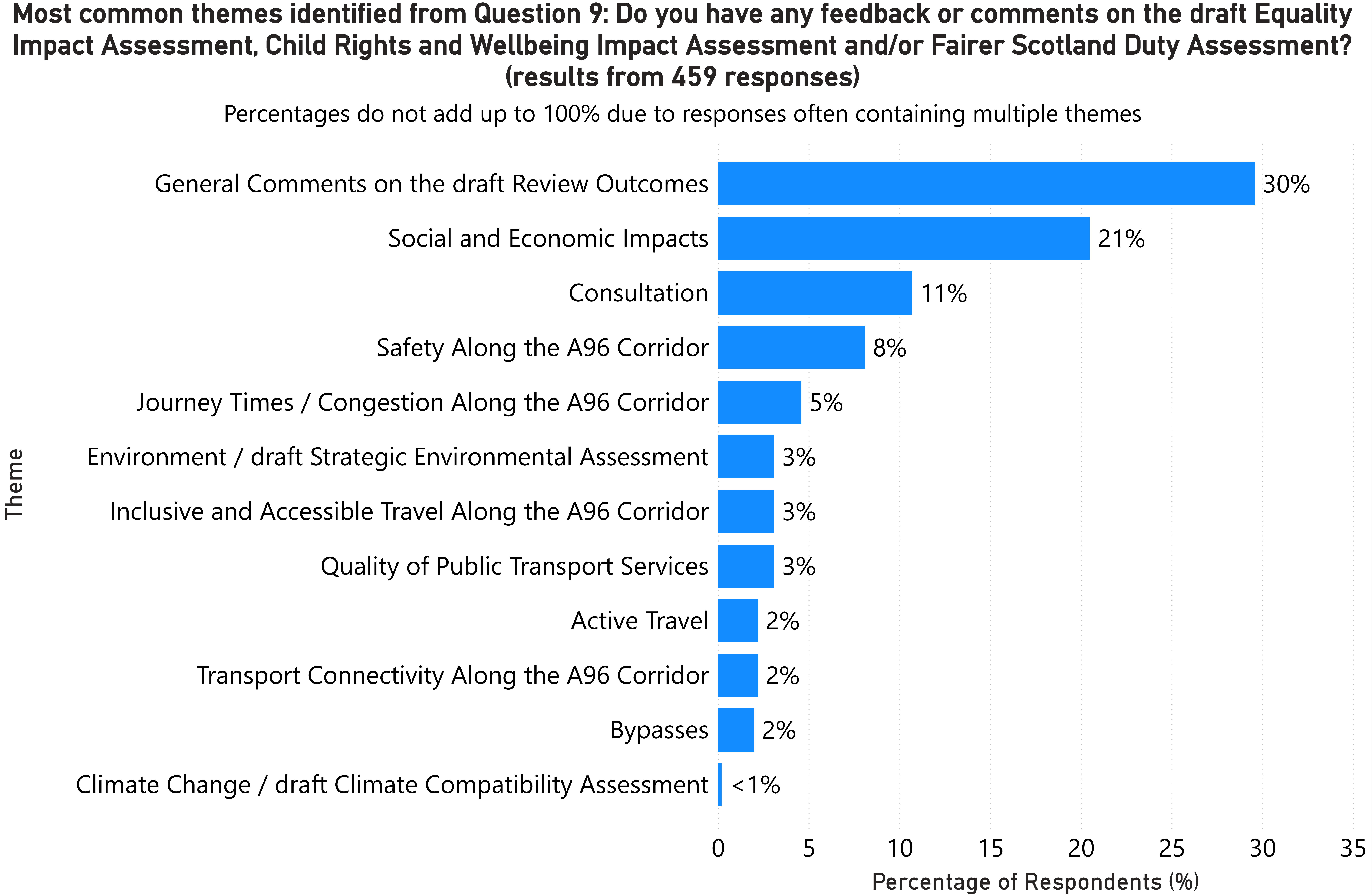
The following section provides a breakdown of the most common topics identified in responses to Question 9 within each theme.
General comments on the draft Review outcomes
Of the 459 responses received for Question 9, 30% were identified as containing topics under the theme of general comments on draft Review outcomes. General comments included support or opposition which could not be categorised within specific criteria of the Review such as safety, environment, or climate change. The most common topics identified under this theme for Question 9 are as follows:
51 respondents express general dissatisfaction with the draft outcomes of the Review, including their opinion that the draft Statutory Impact Assessments (SIAs) are not relevant for a highways scheme, and suggestions that in their opinion there are omissions in the criteria such as environmental justice, social equity, and a lack of location-specific information.
46 respondents provided general support for the Scottish Government’s current commitment to Full Dualling, suggesting that in their opinion Full Dualling would better address the challenges that communities along the corridor face, and would provide improved wellbeing for all users of the A96.
18 respondents expressed frustration as to the time taken to undertake the Review, with additional requests for the Review to conclude to allow improvements to commence without further delay.
15 respondents provided their general support for the draft outcomes of the Review and the draft SIAs, with particular support for the inclusion of equality criteria in the Refined Package.
Social and economic impacts
Of the 459 responses received for Question 9, 21% were identified as containing topics under the theme of social and economic impacts. The most common topics identified under this theme for Question 9 are as follows:
- 39 respondents expressed their opinion that the draft outcomes of the Review represent an example of how the north-east and Highlands are considered to be neglected compared with other regions of Scotland. Respondent views also included that the draft SIAs omitted criteria including historic underfunding and resourcing of infrastructure in the north-east.
31 respondents expressed their opposition to the weighting of the Review criteria, commenting that in their opinion the impact assessments were prioritised too heavily. Respondents also expressed their frustration over the cost of undertaking SIAs, their relevance in the context of a transport infrastructure development, especially the Child’s Rights Assessment, and their benefit for commuters.
Ten respondents commented that the rural landscape of the corridor and long travel distances required to access key amenities results in a heavy reliance on private vehicle usage. Respondents also commented that in their view, without a focus on improving the safety and efficiency of car travel, certain demographics were being discriminated against, such as those who cannot wheel or walk long distances.
Seven respondents expressed their support for Full Dualling, commenting that they believe it would deliver greater economic benefits. Comments highlighted improved connectivity for businesses reliant on travel along the corridor, increased investment potential, and enhanced access to employment opportunities.
Consultation
Of the 459 responses received for Question 9, 11% were identified as containing topics under the theme of consultation. The most common topics identified under this theme for Question 9 are as follows:
18 respondents expressed their concern over the amount of money spent to undertake the consultation, and also suggested that the money would have been better spent on improving the A96.
17 expressed their scepticism over the relevance of the survey questions, including Question 9, on a process to improve infrastructure along the A96 corridor.
Seven respondents commented that they found that the consultation materials were not user-friendly, and the contents of the draft SIAs were inadequate and inaccessible.
Four respondents expressed the view that the consultation was biased to support a pre-determined conclusion, and that the outcomes of the Review have not taken into account the feedback previously provided by businesses and residents.
Safety along the A96 corridor
Of the 459 responses received for Question 9, 8% were identified containing topics under the theme of safety along the A96 corridor. The most common topics identified under this theme for Question 9 are as follows:
11 respondents stated their support for Full Dualling, expressing the view that it would be most effective at delivering improved road and commuter safety along the A96 corridor. Respondents also commented that they believe Full Dualling would benefit emergency service workers, allow for safe overtaking opportunities and would likely reduce accidents along the A96.
11 respondents raised their concerns over the difficulties that emergency service vehicles experience in accessing patients and other emergency service facilities because of congestion that is perceived to result in slower response times. Similarly, concerns were raised from respondents regarding the difficulties they face in accessing healthcare because of slow traffic flow and congestion along the current A96.
Nine respondents noted their views on causes of unsafe driving and accidents along the A96, including speeding, driver frustration and lack of safe overtaking. Specific locations mentioned by respondents included Nairn, Inverurie, Glens of Foudland and Huntly.
Journey times/congestion along the A96 corridor
Of the 459 responses received for Question 9, 5% were identified as containing topics under the theme of journey times and congestion on the A96. This theme includes respondent views on the causes and potential solutions for congestion. The most common topics identified under this theme for Question 9 are as follows:
Nine respondents expressed the view that the physical condition of the road is considered poor and unable to accommodate the required demands, and respondents believe this is hindering future regional development.
Seven respondents commented on issues they believed to be causing congestion along the current A96, including tailbacks caused by lack of overtaking opportunities and slow-moving vehicles such as cyclists, tractors and commercial vehicles. Respondents also cited locations they consider to be congestion hotspots, including between Elgin to Aberdeen.
Three respondents made reference to the Transport Scotland consultation on proposals to reduce the speed limit on single carriage trunk roads to 50mph, which was ongoing at the time of the A96 Corridor Review consultation. Respondents expressed their opinion that the proposals would negatively impact on the current conditions of the A96.
Two respondents stated their support for Full Dualling, commenting that this option would be considered more effective at reducing congestion, delays and journey times along the A96, and also suggested that the Review does not sufficiently address the causes of congestion along the corridor.
Environment/draft Strategic Environmental Assessment
Of the 459 responses received for Question 9, 3% were identified as containing topics under the theme of the environment and draft Strategic Environmental Assessment (SEA). The most common topics identified under this theme for Question 9 are as follows:
Four respondents expressed their dissatisfaction with the weighting of the Review’s criteria, commenting that they believe there is a bias towards environmental impacts, and suggested that the Review’s environmental criteria omitted the impact of poor traffic flow on journey emissions respectively.
Three respondents expressed their support towards prioritising pollution reduction caused by commercial vehicles and buses running through town centres, particularly close to primary schools.
Two respondents stated their support for Full Dualling which they believe would provide benefits to the environment by creating a steady traffic flow, resulting in lower emissions per journey.
Two respondents expressed their support for the incorporation of environmental mitigation into the draft outcomes of the Review, commenting that they consider that the mitigation should not prohibit Full Dualling.
Inclusive and accessible travel along the A96 corridor
Of the 459 responses received Question 9, 3% were identified as containing topics under the theme of inclusive and accessible travel along the A96 corridor. The most common topics identified under this theme for Question 9 are as follows:
11 respondents expressed their support for improving the accessibility of transport along the corridor to make services and facilities more inclusive, especially for residents with disabilities, including focusing on improving public transport services and active travel routes as priorities.
Three respondents expressed their view that members of the public with physical and mental illnesses would benefit more from improvements to the road infrastructure instead of improvements to public transport systems.
Quality of public transport services
Of the 459 responses received for Question 9, 3% were identified as containing topics under the theme of quality of public transport services. The most common topics identified under this theme for Question 9 are as follows:
Eight respondents stated their support for the proposals to improve public transport services along the corridor, expressing their view that this would help alleviate the strain on the current road network. Specific proposals provided by respondents included creating a more integrated public transport network and dual tracking of the rail line across the corridor.
Six respondents commented that they consider the current public transport network inadequate and the services are unreliable, with weekly disruptions and intermittent services which make them an unreliable alternative to private vehicle use.
Active travel
Of the 459 responses received for Question 9, 2% were identified as containing topics under the theme of active travel. The most common topics identified under this theme for Question 9 are as follows:
Four respondents commented on the need for prioritisation of active travel provision to improve the health and wellbeing of children and adults, with respondents also suggesting an accessible and separated cycle path along the A96.
Two respondents expressed their concern over the suitability of proposed active travel routes along a main road and whether the proposed interventions will bring benefits.
Transport connectivity along the A96 corridor
Of the 459 responses received for Question 9, 2% were identified as containing topics under the theme of transport connectivity along the A96 corridor. The most common topics identified under this theme for Question 9 are as follows:
Four respondents stated their support for Full Dualling, commenting that they consider it would be most effective at increasing connectivity and access between towns, settlements and services, and improving accessibility, especially in areas without public transport options.
Three respondents expressed their concern regarding the current standard of route connectivity via public transport. Respondents also included that in their view ineffective and expensive public transport is limiting mobility for children, and that improving connectivity between rural communities would ensure equal opportunities and provide an alternative to cars.
Bypasses
Of the 459 responses received for Question 9, 2% were identified as containing topics under the theme of bypasses. The most common topics identified under this theme for Question 9 are as follows:
Five respondents expressed their views for supporting bypassing towns across the A96 corridor without providing a preference for a specific location.
Two respondents stated their support for bypasses of Elgin and Keith.
Climate change/draft Climate Compatibility Assessment
Of the 459 responses to Question 9, less than 1% contained topics about climate change or the Climate Compatibility Assessment (CCA). The most common topic identified under this theme for Question 9 is as follows:
A respondent commented that any option for transport interventions along the A96 corridor should consider preservation of the planet for future generations.
Support for Full Dualling (open questions)
Alongside the open question analysis methodology outlined in Section 4.2 , further analysis was undertaken of the responses to identify the level of support from respondents for the Scottish Government’s current commitment to Full Dualling of the A96.
In any instance where a respondent provided comments supporting Full Dualling in any of their responses to the open questions, a single affirmative response was noted.
This exercise determined that 63% of the respondents who provided a response to at least one open question, were supportive of Full Dualling of the A96 corridor, although this was not specifically asked in the consultation questionnaire. This figure included both responses which stated general support for dualling and those who commented on specifics as to why, in their view, Full Dualling would be considered the most effective solution to address the problems and opportunities along the corridor.
Opposition to Full Dualling was also analysed, with 7% of respondents stating they were against Full Dualling. This figure included respondents who suggested that in their view there was no requirement to dual the road to address the problems on the A96, that it would be too expensive, and that it would have too negative an effect on the environment.